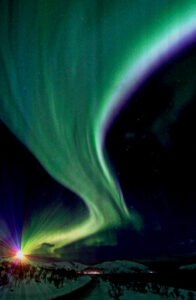In Search of the Northern Lights01 Oct 2014
 If you are like most Americans living in the lower 48 states, you probably have never seen the Aurora Borealis, or Northern Lights – or at least not in all their glory. This really can be a magical sight to behold. Caused by electrically charged particles from the sun entering and colliding with gaseous particles in our earth’s atmosphere, these colorful displays of light range from blue, purple, green and red. The color is determined by the distance from the earth’s surface.
If you are like most Americans living in the lower 48 states, you probably have never seen the Aurora Borealis, or Northern Lights – or at least not in all their glory. This really can be a magical sight to behold. Caused by electrically charged particles from the sun entering and colliding with gaseous particles in our earth’s atmosphere, these colorful displays of light range from blue, purple, green and red. The color is determined by the distance from the earth’s surface.
Did you know that there are vacations organized around viewing this phenomenon at peak times? Although they can sometimes be seen during any time of the year and even far from the north pole, optimum viewing is during winter when nights are longer, typically from October through March. Due to heavy snowfall in Alaska and Canada, early spring is usually the best time of the year in that area, but tours and independent trips are available beginning in October. There are great opportunities to experience the Aurora Borealis in Iceland and Greenland as well as Scandinavia and Siberia.
A winter holiday in Alaska or Canada can include not only a fun Northern Lights hunt late in the evening, but many other activities such as snowmobiling, dogsledding, and soaking in a hot springs. Iceland truly is a winter playground, offering a variety of activities such as super jeep tours, snowmobiling, glacier hikes and boasts a number of beautiful hot springs to enjoy including the infamous “Blue Lagoon.” You can even enjoy the Northern Lights on a cruise, such as with Hurtigruten Cruises out of Norway. Seeing the Southern Lights, or Aurora Australis, is a bit more difficult as the best viewing is in Antarctica, but they can also be seen from southern Chile or Argentina and from southern New Zealand and Australia from time to time.



